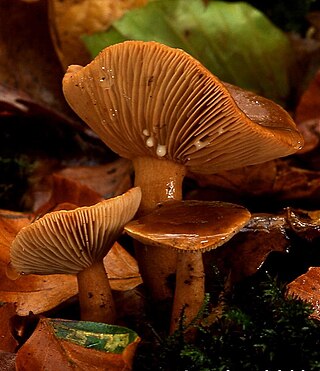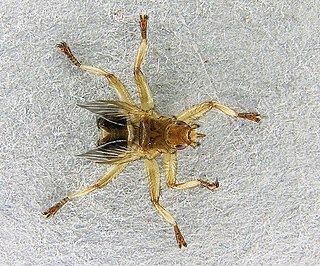
Hamsters are rodents belonging to the subfamily Cricetinae, which contains 19 species classified in seven genera. They have become established as popular small pets. The best-known species of hamster is the golden or Syrian hamster, which is the type most commonly kept as a pet. Other hamster species commonly kept as pets are the three species of dwarf hamster, Campbell's dwarf hamster, the winter white dwarf hamster and the Roborovski hamster.

Weasels are mammals of the genus Mustela of the family Mustelidae. The genus Mustela includes the least weasels, polecats, stoats, ferrets, and European mink. Members of this genus are small, active predators, with long and slender bodies and short legs. The family Mustelidae, or mustelids, is often referred to as the "weasel family". In the UK, the term "weasel" usually refers to the smallest species, the least weasel (M. nivalis), the smallest carnivoran species.

Genus is a taxonomic rank used in the biological classification of living and fossil organisms as well as viruses. In the hierarchy of biological classification, genus comes above species and below family. In binomial nomenclature, the genus name forms the first part of the binomial species name for each species within the genus.

In taxonomy, binomial nomenclature, also called binary nomenclature, is a formal system of naming species of living things by giving each a name composed of two parts, both of which use Latin grammatical forms, although they can be based on words from other languages. Such a name is called a binomial name, a binomen, binominal name, or a scientific name; more informally it is also historically called a Latin name. In the ICZN, the system is also called binominal nomenclature, "binomi'N'al" with an "N" before the "al", which is not a typographic error, meaning "two-name naming system".

Moles are small mammals adapted to a subterranean lifestyle. They have cylindrical bodies, velvety fur, very small, inconspicuous eyes and ears, reduced hindlimbs, and short, powerful forelimbs with large paws adapted for digging.

Vespertilionidae is a family of microbats, of the order Chiroptera, flying, insect-eating mammals variously described as the common, vesper, or simple nosed bats. The vespertilionid family is the most diverse and widely distributed of bat families, specialised in many forms to occupy a range of habitats and ecological circumstances, and it is frequently observed or the subject of research. The facial features of the species are often simple, as they mainly rely on vocally emitted echolocation. The tails of the species are enclosed by the lower flight membranes between the legs. Over 300 species are distributed all over the world, on every continent except Antarctica. It owes its name to the genus Vespertilio, which takes its name from a word for bat, vespertilio, derived from the Latin term vesper meaning 'evening'; they are termed "evening bats" and were once referred to as "evening birds".

Rails are a large, cosmopolitan family of small- to medium-sized terrestrial and/or semi-amphibious birds. The family exhibits considerable diversity in its forms, and includes such ubiquitous species as the crakes, coots, and gallinule; other rail species are extremely rare or endangered. Many are associated with wetland habitats, some being semi-aquatic like waterfowl, but many more are wading birds or shorebirds. The ideal rail habitats are marsh areas, including rice paddies, and flooded fields or open forest. They are especially fond of dense vegetation for nesting. The rail family is found in every terrestrial habitat with the exception of dry desert, polar or freezing regions, and alpine areas. Members of Rallidae occur on every continent except Antarctica. Numerous unique island species are known.

Bufo is a genus of true toads in the amphibian family Bufonidae. As traditionally defined, it was a wastebasket genus containing a large number of toads from much of the world but following taxonomic reviews most of these have been moved to other genera, leaving only seventeen extant species from Europe, northern Africa and Asia in this genus, including the well-known common toad. Some of the genera that contain species formerly placed in Bufo are Anaxyrus, Bufotes, Duttaphrynus, Epidalea and Rhinella.

Starlings are small to medium-sized passerine birds in the family Sturnidae, common name of Sturnid. The Sturnidae are named for the genus Sturnus, which in turn comes from the Latin word for starling, sturnus. The family contains 128 species which are divided into 36 genera. Many Asian species, particularly the larger ones, are called mynas, and many African species are known as glossy starlings because of their iridescent plumage. Starlings are native to Europe, Asia, and Africa, as well as northern Australia and the islands of the tropical Pacific. Several European and Asian species have been introduced to these areas, as well as North America, Hawaii, and New Zealand, where they generally compete for habitats with native birds and are considered to be invasive species. The starling species familiar to most people in Europe and North America is the common starling, and throughout much of Asia and the Pacific, the common myna is indeed common.

Iniidae is a family of river dolphins containing one living genus, Inia, and four extinct genera. The extant genus inhabits the river basins of South America, but the family formerly had a wider presence across the Atlantic Ocean.

In mycology, a lamella, or gill, is a papery hymenophore rib under the cap of some mushroom species, most often agarics. The gills are used by the mushrooms as a means of spore dispersal, and are important for species identification. The attachment of the gills to the stem is classified based on the shape of the gills when viewed from the side, while color, crowding and the shape of individual gills can also be important features. Additionally, gills can have distinctive microscopic or macroscopic features. For instance, Lactarius species typically seep latex from their gills.

A salp or salpa is a barrel-shaped, planktonic tunicate in the family Salpidae. It moves by contracting, thereby pumping water through its gelatinous body, one of the most efficient examples of jet propulsion in the animal kingdom. The salp strains the pumped water through its internal feeding filters, feeding on phytoplankton.

African tetras are a group of characiform fish found exclusively in Africa. This family contains about 18 genera and 119 species. Among the best known members are the Congo tetra, and African tigerfish.

Acacia, commonly known as wattles or acacias, is a genus of about 1084 species of shrubs and trees in the subfamily Mimosoideae of the pea family Fabaceae. Initially, it comprised a group of plant species native to Africa, South America and Australasia, but is now reserved for species mainly from Australia, with others from New Guinea, Southeast Asia and the Indian Ocean. The genus name is Neo-Latin, borrowed from the Greek ἀκακία, a term used by Dioscorides for a preparation extracted from the leaves and fruit pods of Vachellia nilotica, the original type of the genus. In his Pinax (1623), Gaspard Bauhin mentioned the Greek ἀκακία from Dioscorides as the origin of the Latin name.

Hippoboscidae, the louse flies or keds, are obligate parasites of mammals and birds. In this family, the winged species can fly at least reasonably well, though others with vestigial or no wings are flightless and highly apomorphic. As usual in their superfamily Hippoboscoidea, most of the larval development takes place within the mother's body, and pupation occurs almost immediately.
Thomandersia is the sole genus in the Thomandersiaceae, an African family of flowering plants. Thomandersia is a genus of shrubs and small trees, with six species native to Central and West Africa.

Glyptemys is a genus of turtles in the family Emydidae. It comprises two species, the bog turtle and wood turtle, both of which are endemic to North America. Until 2001, these turtles were considered members of the genus Clemmys, which currently has one member, the spotted turtle.

Eels are ray-finned fish belonging to the order Anguilliformes, which consists of eight suborders, 20 families, 164 genera, and about 1000 species. Eels undergo considerable development from the early larval stage to the eventual adult stage and are usually predators.

A species is often defined as the largest group of organisms in which any two individuals of the appropriate sexes or mating types can produce fertile offspring, typically by sexual reproduction. It is the basic unit of classification and a taxonomic rank of an organism, as well as a unit of biodiversity. Other ways of defining species include their karyotype, DNA sequence, morphology, behaviour, or ecological niche. In addition, paleontologists use the concept of the chronospecies since fossil reproduction cannot be examined.
Pseudoglyptodon is a genus of extinct sloths from South America. The type species is Pseudoglyptodon sallaensis.
















